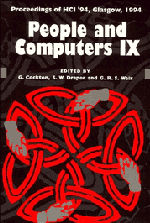Book contents
- Frontmatter
- Contents
- Preface: HCI'94 – You Probably Haven't Seen It All Before
- Part I Invited Papers
- Part II Methodology of Interactive Systems Development
- Crafting Interaction: Styles, Metaphors, Modalities and Agents
- Modelling Humans, Computers and their Interaction
- 18 Multi-Perspective Modelling of Interface Design Issues: Undo in a Collaborative Editor
- 19 Qualitative Models of User Interfaces
- 20 Modelling Interaction using Template Abstractions
- 21 The Formal Analysis of Human-Computer Interaction During Accident Investigations
- Notations and Tools for Design
- Part VI Computer-Supported Cooperative Work
- Author Index
- Keyword Index
20 - Modelling Interaction using Template Abstractions
Published online by Cambridge University Press: 04 August 2010
- Frontmatter
- Contents
- Preface: HCI'94 – You Probably Haven't Seen It All Before
- Part I Invited Papers
- Part II Methodology of Interactive Systems Development
- Crafting Interaction: Styles, Metaphors, Modalities and Agents
- Modelling Humans, Computers and their Interaction
- 18 Multi-Perspective Modelling of Interface Design Issues: Undo in a Collaborative Editor
- 19 Qualitative Models of User Interfaces
- 20 Modelling Interaction using Template Abstractions
- 21 The Formal Analysis of Human-Computer Interaction During Accident Investigations
- Notations and Tools for Design
- Part VI Computer-Supported Cooperative Work
- Author Index
- Keyword Index
Summary
The use of formal system models in interface development is often criticised for failing to recognise the ‘human’ nature of interaction. This paper describes an abstract system model of interaction, termed the template model, which is designed to address this criticism (Roast, 1993). The template model relies upon the identification of template abstractions which are system components that have particular user significance. By employing template abstractions system properties can be linked closely to user requirements. Using this framework we describe two categories of system constraint that express general usability requirements output correctness and structural consistency.
The appropriateness of the perspective offered by the template model and the requirements expressed using it are illustrated in the analysis of an electronic mail system.
Keywords: formal methods, system modelling, interaction models, email.
Introduction
To ensure that interactive systems are used effectively it is accepted that intended users should have a central role in system development. From the point of view of system specification and development, this concern is met by normally requiring that a system and its operating environment be modelled. In the case of HCI, users of a system are the principal environment with which the system interacts. Hence ideally developers should consider modelling users in conjunction with the system being designed — for example see (Barnard & Harrison, 1989; Barnard & Harrison, 1992). In practice efforts to model system users have not provided sufficient accuracy and generality to reliably support software development. Commonly user models are used solely as evaluation mechanisms, and are not in a form that would relate to a design representation.
- Type
- Chapter
- Information
- People and Computers , pp. 273 - 284Publisher: Cambridge University PressPrint publication year: 1994
- 5
- Cited by

